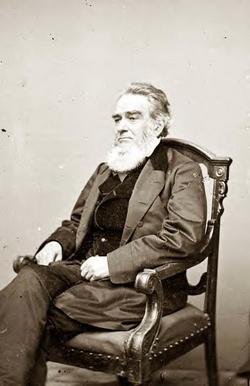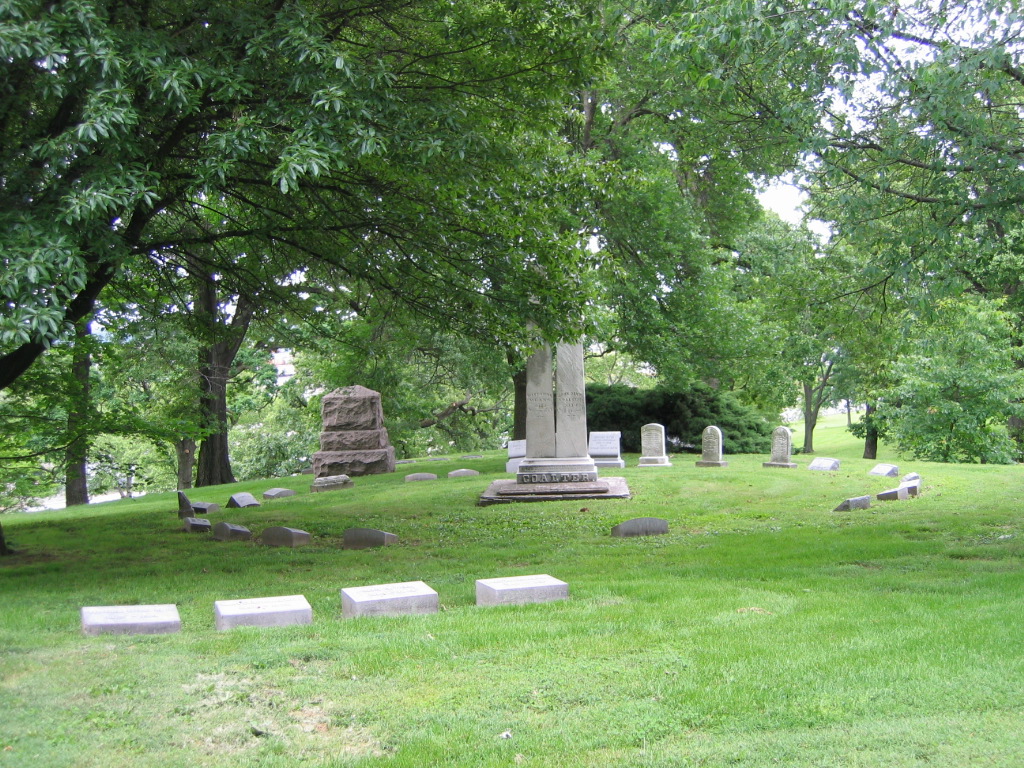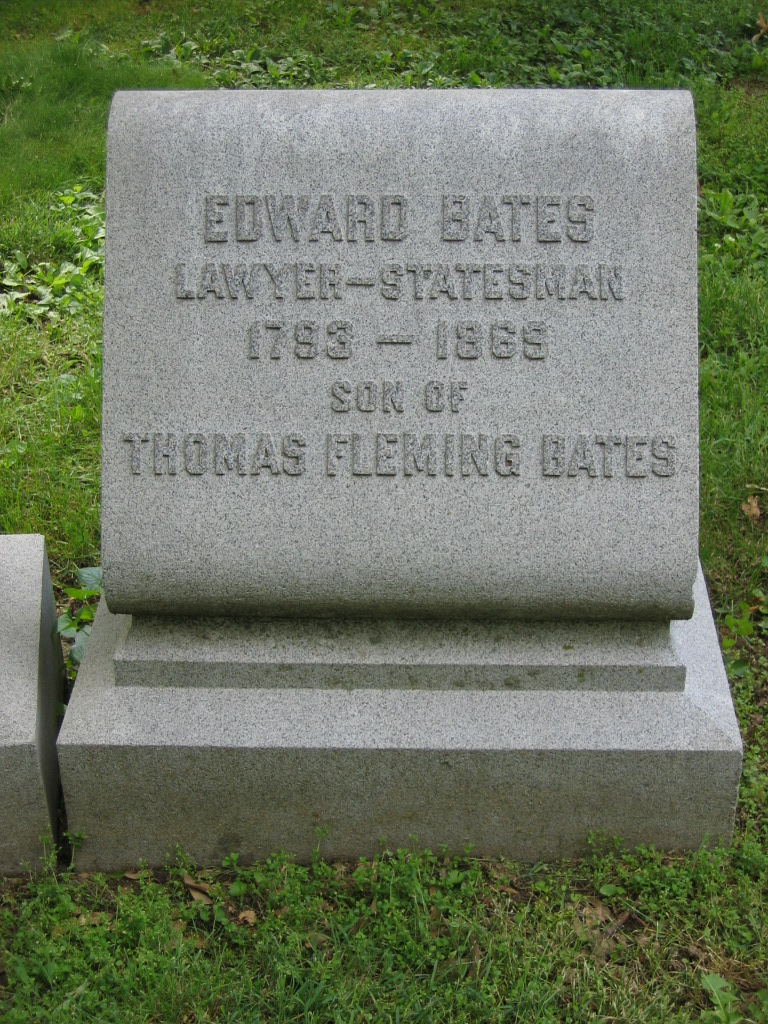US Congressman, Presidential Cabinet Secretary. He served the State of Missouri in the United States House of Representatives for one term starting in 1826. He was a member of the Whig Party until 1856 when he inevitably gravitated to the newly-created Republican Party. After Abraham Lincoln's 1860 election, Bates accepted Lincoln's offer to become the 26th United States Attorney General, serving from March 5, 1861, which was a mere six weeks before the start of the American Civil War. As attorney general, Bates wrote important legal opinions on war issues, including briefs in support of Lincoln's suspension of the writ of habeas corpus and of the right to seize ships to enforce the Union's blockade of Southern ports. In mid-1862, he joined with others in pressuring Lincoln for the removal of General George McClellan from the position of General-in-Chief of all Union armies. He had to rule on the issue of military arrests of civilians during the war, deciding that since the arrests were military, the situation would fall under the Commander and Chief of the Military or his appointed person. In this era, there was no real Justice Department as he only had six office staff members and the other cabinet members available for advice. Disappointed in not receiving Lincoln's nomination for the position of Chief Justice of the Supreme Court in 1864, Bates resigned on November 24, 1864, and returned to St. Louis to practice law and write newspaper articles on politics. He had a lifelong habit of keeping the strictest rules of law, and the war was causing the rules to bend. From a personal viewpoint of the war, his son Fleming Bates served in the Confederate Army, and another son, John C. Bates, served in the Union Army, while his youngest son, Charles, was at West Point during most of the war. Born in Virginia on a plantation that was worked by the enslaved, he was educated at Charlotte Hall Academy in Maryland and by a private tutor before serving in the Virginia Militia from February until October of 1813 during the War of 1812. He migrated from Virginia to the Territory of Missouri in 1814, studied law for two years, joined a law practice, and was a prosecuting attorney for the St. Louis circuit by 1818. When the state government was organized in 1820, Bates was appointed Missouri's first attorney general at age 27. He helped write the state's pro-slavery Constitution. After the 1850 Slave Schedule, he freed his two slaves, which he had inherited. In the next 15 years, he served in the Missouri House of Representatives from 1824 to 1826, the U.S. House of Representatives as the only Congressman from Missouri, and the Missouri Senate in 1830 and 1834. After leaving the House of Representatives, he was a candidate for a US Senate seat but was defeated in the election by a Democrat, and in 1828, he lost the bid to return to the House of Representatives. In the courtroom, he successfully argued in Lucy Delaney's Freedom case, freeing his client from from being enslaved in February of 1844. In 1850, President Fillmore offered him the post of Secretary of War, which he declined. In 1853, he became judge of the St. Louis land court, presided over the Whig Convention in Baltimore in 1856, became prominent as an anti-slavery man, and in 1859 was considered for the United States Presidency. His Presidential candidacy was promoted by the "New York Tribune" editor Horace Greeley and the prominent political Blair family, but opposed by those who wanted a younger candidate; he was 67 years old. After Bates accepted Lincoln's offer to become the United States Attorney General, he became the first cabinet officer from west of the Mississippi River, as well as the oldest member of Lincoln's 1st cabinet. The official photograph of him sitting in a high back chair was taken by the well-known American Civil War photographer Matthew Brady. The photograph eventually became the property of Emperor Pedro II of Brazil. A formal portrait painting, Bates was done by Alban Jasper Conant in 1861 and is on display at the Department of Justice. In 1860, William Cogswell painted an oil-on-canvas portrait of Bates, which is on display at the Missouri History Museum. Bates has a bronze statue, which was dedicated in 1876 with the dedication of St. Louis' Forest Park, the location of the statue. In 1823, he married a South Carolina lady, Julia Coalter, and the couple had seventeen children, with nine living to adulthood.
US Congressman, Presidential Cabinet Secretary. He served the State of Missouri in the United States House of Representatives for one term starting in 1826. He was a member of the Whig Party until 1856 when he inevitably gravitated to the newly-created Republican Party. After Abraham Lincoln's 1860 election, Bates accepted Lincoln's offer to become the 26th United States Attorney General, serving from March 5, 1861, which was a mere six weeks before the start of the American Civil War. As attorney general, Bates wrote important legal opinions on war issues, including briefs in support of Lincoln's suspension of the writ of habeas corpus and of the right to seize ships to enforce the Union's blockade of Southern ports. In mid-1862, he joined with others in pressuring Lincoln for the removal of General George McClellan from the position of General-in-Chief of all Union armies. He had to rule on the issue of military arrests of civilians during the war, deciding that since the arrests were military, the situation would fall under the Commander and Chief of the Military or his appointed person. In this era, there was no real Justice Department as he only had six office staff members and the other cabinet members available for advice. Disappointed in not receiving Lincoln's nomination for the position of Chief Justice of the Supreme Court in 1864, Bates resigned on November 24, 1864, and returned to St. Louis to practice law and write newspaper articles on politics. He had a lifelong habit of keeping the strictest rules of law, and the war was causing the rules to bend. From a personal viewpoint of the war, his son Fleming Bates served in the Confederate Army, and another son, John C. Bates, served in the Union Army, while his youngest son, Charles, was at West Point during most of the war. Born in Virginia on a plantation that was worked by the enslaved, he was educated at Charlotte Hall Academy in Maryland and by a private tutor before serving in the Virginia Militia from February until October of 1813 during the War of 1812. He migrated from Virginia to the Territory of Missouri in 1814, studied law for two years, joined a law practice, and was a prosecuting attorney for the St. Louis circuit by 1818. When the state government was organized in 1820, Bates was appointed Missouri's first attorney general at age 27. He helped write the state's pro-slavery Constitution. After the 1850 Slave Schedule, he freed his two slaves, which he had inherited. In the next 15 years, he served in the Missouri House of Representatives from 1824 to 1826, the U.S. House of Representatives as the only Congressman from Missouri, and the Missouri Senate in 1830 and 1834. After leaving the House of Representatives, he was a candidate for a US Senate seat but was defeated in the election by a Democrat, and in 1828, he lost the bid to return to the House of Representatives. In the courtroom, he successfully argued in Lucy Delaney's Freedom case, freeing his client from from being enslaved in February of 1844. In 1850, President Fillmore offered him the post of Secretary of War, which he declined. In 1853, he became judge of the St. Louis land court, presided over the Whig Convention in Baltimore in 1856, became prominent as an anti-slavery man, and in 1859 was considered for the United States Presidency. His Presidential candidacy was promoted by the "New York Tribune" editor Horace Greeley and the prominent political Blair family, but opposed by those who wanted a younger candidate; he was 67 years old. After Bates accepted Lincoln's offer to become the United States Attorney General, he became the first cabinet officer from west of the Mississippi River, as well as the oldest member of Lincoln's 1st cabinet. The official photograph of him sitting in a high back chair was taken by the well-known American Civil War photographer Matthew Brady. The photograph eventually became the property of Emperor Pedro II of Brazil. A formal portrait painting, Bates was done by Alban Jasper Conant in 1861 and is on display at the Department of Justice. In 1860, William Cogswell painted an oil-on-canvas portrait of Bates, which is on display at the Missouri History Museum. Bates has a bronze statue, which was dedicated in 1876 with the dedication of St. Louis' Forest Park, the location of the statue. In 1823, he married a South Carolina lady, Julia Coalter, and the couple had seventeen children, with nine living to adulthood.
Bio by: Linda Davis
Inscription
Lawyer Statesman
Son of Thomas Fleming Bates
Family Members
Advertisement




















